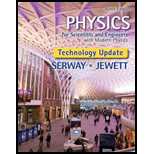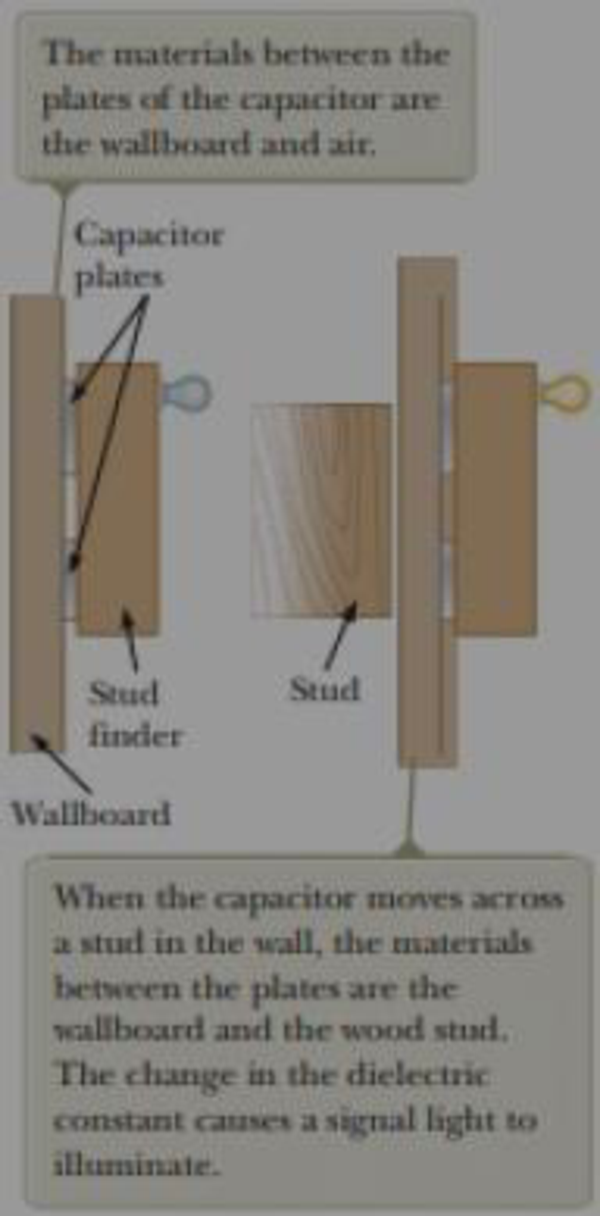
Physics for Scientists and Engineers with Modern Physics, Technology Update
9th Edition
ISBN: 9781305401969
Author: SERWAY, Raymond A.; Jewett, John W.
Publisher: Cengage Learning
expand_more
expand_more
format_list_bulleted
Concept explainers
Textbook Question
Chapter 26.5, Problem 26.5QQ
If you have ever tried to hang a picture or a mirror, you know it can be difficult to locate a wooden stud in which to anchor your nail or screw. A carpenter’s stud finder is a capacitor with its plates arranged side by side instead of facing each other as shown in Figure 25.14. When the device is moved over a stud, does the capacitance (a) increase or (b) decrease?

Expert Solution & Answer
Want to see the full answer?
Check out a sample textbook solution
Students have asked these similar questions
A Geiger-Mueller tube is a radiation detector that consists of a closed, hollow, metal cylinder (the cathode) of inner radius ra and a coaxial cylindrical wire (the anode) of radius г (see figure below) with a gas filling the
space between the electrodes. Assume that the internal diameter of a Geiger-Mueller tube is 3.00 cm and that the wire along the axis has a diameter of 0.190 mm. The dielectric strength of the gas between the central wire
and the cylinder is 1.15 × 106 V/m. Use the equation 2πrlE =
9in
to calculate the maximum potential difference that can be applied between the wire and the cylinder before breakdown occurs in the gas.
V
Anode
Cathode
3.77 is not the correct answer!
A
I
squar frame has sides that measure 2.45m when it is at rest.
What is the area of the frame when it moves parellel to one
of
its diagonal with a
m²
speed of 0.86.c as indicated in the figure?
>V.
Chapter 26 Solutions
Physics for Scientists and Engineers with Modern Physics, Technology Update
Ch. 26.1 - A capacitor stores charge Q at a potential...Ch. 26.2 - Many computer keyboard buttons are constructed of...Ch. 26.3 - Two capacitors are identical. They can be...Ch. 26.4 - You have three capacitors and a battery. In which...Ch. 26.5 - If you have ever tried to hang a picture or a...Ch. 26 - Prob. 1OQCh. 26 - Prob. 2OQCh. 26 - Prob. 3OQCh. 26 - Prob. 4OQCh. 26 - Prob. 5OQ
Ch. 26 - Prob. 6OQCh. 26 - Prob. 7OQCh. 26 - Prob. 8OQCh. 26 - Prob. 9OQCh. 26 - Prob. 10OQCh. 26 - Prob. 11OQCh. 26 - Prob. 12OQCh. 26 - Prob. 13OQCh. 26 - Prob. 14OQCh. 26 - Prob. 1CQCh. 26 - Prob. 2CQCh. 26 - Prob. 3CQCh. 26 - Explain why a dielectric increases the maximum...Ch. 26 - Prob. 5CQCh. 26 - Prob. 6CQCh. 26 - Prob. 7CQCh. 26 - Prob. 8CQCh. 26 - (a) When a battery is connected to the plates of a...Ch. 26 - Two conductors having net charges of +10.0 C and...Ch. 26 - Prob. 3PCh. 26 - An air-filled parallel-plate capacitor has plates...Ch. 26 - Prob. 5PCh. 26 - Prob. 6PCh. 26 - When a potential difference of 150 V is applied to...Ch. 26 - Prob. 8PCh. 26 - Prob. 9PCh. 26 - Prob. 10PCh. 26 - Prob. 11PCh. 26 - Review. A small object of mass m carries a charge...Ch. 26 - Prob. 13PCh. 26 - Prob. 14PCh. 26 - Find the equivalent capacitance of a 4.20-F...Ch. 26 - Given a 2.50-F capacitor, a 6.25-F capacitor, and...Ch. 26 - Prob. 17PCh. 26 - Prob. 18PCh. 26 - Prob. 19PCh. 26 - Prob. 20PCh. 26 - A group of identical capacitors is connected first...Ch. 26 - Prob. 22PCh. 26 - Four capacitors are connected as shown in Figure...Ch. 26 - Prob. 24PCh. 26 - Prob. 25PCh. 26 - Prob. 26PCh. 26 - Two capacitors give an equivalent capacitance of...Ch. 26 - Prob. 28PCh. 26 - Prob. 29PCh. 26 - Prob. 30PCh. 26 - Prob. 31PCh. 26 - A 3.00-F capacitor is connected to a 12.0-V...Ch. 26 - Prob. 33PCh. 26 - Prob. 34PCh. 26 - Prob. 35PCh. 26 - Two identical parallel-plate capacitors, each with...Ch. 26 - Two capacitors, C1 = 25.0 F and C2 = 5.00 F, are...Ch. 26 - A parallel-plate capacitor has a charge Q and...Ch. 26 - Prob. 39PCh. 26 - Prob. 40PCh. 26 - Prob. 41PCh. 26 - Prob. 42PCh. 26 - Prob. 43PCh. 26 - Prob. 44PCh. 26 - Determine (a) the capacitance and (b) the maximum...Ch. 26 - Prob. 46PCh. 26 - Prob. 47PCh. 26 - Prob. 48PCh. 26 - Prob. 49PCh. 26 - Prob. 50PCh. 26 - An infinite line of positive charge lies along the...Ch. 26 - Prob. 52PCh. 26 - Prob. 53PCh. 26 - Prob. 54APCh. 26 - Prob. 55APCh. 26 - Prob. 56APCh. 26 - A uniform electric field E = 3 000 V/m exists...Ch. 26 - Prob. 58APCh. 26 - Prob. 59APCh. 26 - Why is the following situation impossible? A...Ch. 26 - Prob. 61APCh. 26 - A parallel-plate capacitor with vacuum between its...Ch. 26 - Prob. 63APCh. 26 - Prob. 64APCh. 26 - Prob. 65APCh. 26 - (a) Two spheres have radii a and b, and their...Ch. 26 - Prob. 67APCh. 26 - A parallel-plate capacitor of plate separation d...Ch. 26 - Prob. 69APCh. 26 - Prob. 70APCh. 26 - To repair a power supply for a stereo amplifier,...Ch. 26 - Prob. 72CPCh. 26 - Prob. 73CPCh. 26 - Consider two long, parallel, and oppositely...Ch. 26 - Prob. 75CPCh. 26 - Prob. 76CPCh. 26 - Prob. 77CPCh. 26 - Prob. 78CP
Additional Science Textbook Solutions
Find more solutions based on key concepts
Choose the best answer to each of the following. Explain your reasoning. If Earth were twice as far as it actua...
Cosmic Perspective Fundamentals
On what molecule does the anticodon appear? Explain the role of this molecule in protein synthesis.
Human Physiology: An Integrated Approach (8th Edition)
Why is it unlikely that two neighboring water molecules would be arranged like this?
Campbell Biology (11th Edition)
Why is it necessary to be in a pressurized cabin when flying at 30,000 feet?
Anatomy & Physiology (6th Edition)
Separate the list P,F,V,,T,a,m,L,t, and V into intensive properties, extensive properties, and nonproperties.
Fundamentals Of Thermodynamics
What process causes the Mediterranean intermediate Water MIW to become more dense than water in the adjacent At...
Applications and Investigations in Earth Science (9th Edition)
Knowledge Booster
Learn more about
Need a deep-dive on the concept behind this application? Look no further. Learn more about this topic, physics and related others by exploring similar questions and additional content below.Similar questions
- An astronent travels to a distant star with a speed of 0.44C relative to Earth. From the austronaut's point of view, the star is 420 ly from Earth. On the return trip, the astronent travels speed of 0.76c relative to Earth. What is the distance covered on the return trip, as measured by the astronant? your answer in light-years. with a Give ly.arrow_forwardstar by spaceship Sixus is about 9.00 ly from Earth. To preach the star in 15.04 (ship time), how fast must you travel? C.arrow_forwardIf light-bulb A is unscrewed, how will the brightness of bulbs B and C change, if at all? How does the current drawn by from the battery change?arrow_forward
- Can someone help mearrow_forwardCan someone help me with this thank youarrow_forward(a) For a spherical capacitor with inner radius a and outer radius b, we have the following for the capacitance. ab C = k₂(b- a) 0.0695 m 0.145 m (8.99 × 10º N · m²/c²)( [0.145 m- 0.0695 m × 10-11 F = PF IIarrow_forward
- A pendulum bob A (0.5 kg) is given an initialspeed of vA = 4 m/s when the chord ishorizontal. It then hits a stationary block B (1kg) which then slides to a maximum distanced before it stops. Determine the value of d.The coefficient of static friction between theblock and the plane is μk = 0.2. The coefficientof restitution between A and B is e = 0.8.Ans: d=1.0034 marrow_forwardFigure 29-43 Problem 12. ••13 In Fig. 29-44, point P₁ is at distance R = 13.1 cm on the perpendicular bisector of a straight wire of length L = 18.0 cm carrying current i = 58.2 mA. (Note that the wire is not long.) What is the magnitude of the magnetic field at P₁ due to i? P2° R R Larrow_forwardCheckpoint 1 The figure shows the current i in a single-loop circuit with a battery B and a resistance R (and wires of neg- ligible resistance). (a) Should the emf arrow at B be drawn pointing leftward or rightward? At points a, B C R b, and c, rank (b) the magnitude of the current, (c) the electric potential, and (d) the electric potential energy of the charge carriers, greatest first.arrow_forward
arrow_back_ios
SEE MORE QUESTIONS
arrow_forward_ios
Recommended textbooks for you
 Physics for Scientists and Engineers: Foundations...PhysicsISBN:9781133939146Author:Katz, Debora M.Publisher:Cengage Learning
Physics for Scientists and Engineers: Foundations...PhysicsISBN:9781133939146Author:Katz, Debora M.Publisher:Cengage Learning Principles of Physics: A Calculus-Based TextPhysicsISBN:9781133104261Author:Raymond A. Serway, John W. JewettPublisher:Cengage Learning
Principles of Physics: A Calculus-Based TextPhysicsISBN:9781133104261Author:Raymond A. Serway, John W. JewettPublisher:Cengage Learning College PhysicsPhysicsISBN:9781285737027Author:Raymond A. Serway, Chris VuillePublisher:Cengage Learning
College PhysicsPhysicsISBN:9781285737027Author:Raymond A. Serway, Chris VuillePublisher:Cengage Learning Physics for Scientists and Engineers with Modern ...PhysicsISBN:9781337553292Author:Raymond A. Serway, John W. JewettPublisher:Cengage Learning
Physics for Scientists and Engineers with Modern ...PhysicsISBN:9781337553292Author:Raymond A. Serway, John W. JewettPublisher:Cengage Learning Physics for Scientists and EngineersPhysicsISBN:9781337553278Author:Raymond A. Serway, John W. JewettPublisher:Cengage Learning
Physics for Scientists and EngineersPhysicsISBN:9781337553278Author:Raymond A. Serway, John W. JewettPublisher:Cengage Learning

Physics for Scientists and Engineers: Foundations...
Physics
ISBN:9781133939146
Author:Katz, Debora M.
Publisher:Cengage Learning

Principles of Physics: A Calculus-Based Text
Physics
ISBN:9781133104261
Author:Raymond A. Serway, John W. Jewett
Publisher:Cengage Learning

College Physics
Physics
ISBN:9781285737027
Author:Raymond A. Serway, Chris Vuille
Publisher:Cengage Learning

Physics for Scientists and Engineers with Modern ...
Physics
ISBN:9781337553292
Author:Raymond A. Serway, John W. Jewett
Publisher:Cengage Learning

Physics for Scientists and Engineers
Physics
ISBN:9781337553278
Author:Raymond A. Serway, John W. Jewett
Publisher:Cengage Learning

Physics Capacitor & Capacitance part 7 (Parallel Plate capacitor) CBSE class 12; Author: LearnoHub - Class 11, 12;https://www.youtube.com/watch?v=JoW6UstbZ7Y;License: Standard YouTube License, CC-BY